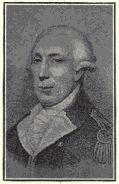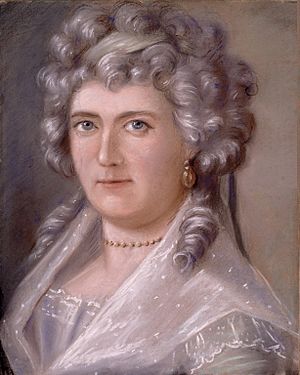John Munro (loyalist) facts for kids
Quick facts for kids
Captain John Munro
|
|
|---|---|
 |
|
| Member of the Legislative Council of Upper Canada | |
| In office 1792–1800 |
|
| Personal details | |
| Born | 1728 Alness, Ross-shire, Scotland |
| Died | October 27, 1800 (aged 71–72) Dickinson's Landing, Upper Canada |
| Spouse | Marie Talbot Gilbert Brouwer |
| Residences | "Fowlis" Albany County, New York |
John Munro (born in 1728, died October 27, 1800) was an important figure in early Canadian history. He was a soldier from the Scottish Highlands. After fighting in the Seven Years' War, he received a lot of land in Albany, New York.
Munro became a successful merchant and a strong supporter of the British Crown, known as a Loyalist. He fought for the British during the American Revolutionary War. After the war, he lost his land in America. He then moved to Upper Canada (now part of Ontario). There, he became a Judge and was chosen for the first Legislative Council of Upper Canada.
Contents
Who Was John Munro?
John Munro was born in 1728 in Alness, Scotland. His family came from the important Clan Munro. His parents were Hugh Munro and Christiana Munro. Both of his parents were related to the chiefs of Clan Munro.
When he later got land in Albany, New York, he named his large property 'Fowlis'. This name honored Foulis Castle, the ancient home of his family in Scotland.
Life in New York
John Munro started his military career as a Sergeant-Major. He came to North America in 1756. He fought in the Seven Years' War at places like Louisburg and Quebec.
After the war, he received large land grants in Albany County, New York. His estate, "Fowlis," grew to over 11,000 acres. He became a successful merchant, especially in the fur trade. He was a close friend of Simon McTavish, a famous fur trader. Munro also served as a magistrate, which is like a local judge, in Albany County.
Challenges in Vermont
Around 1765, John Munro moved his family to Shaftsbury, Vermont. He continued to farm and run businesses like mills and factories. He was sent there to help control Ethan Allen and the Green Mountain Boys. These groups were causing trouble over land disputes.
In 1771, Munro tried to arrest Remember Baker, a leader of the Green Mountain Boys. Munro's group captured Baker, but the Green Mountain Boys ambushed them and rescued Baker. Munro reported that the fight was very dangerous. He said he was lucky to survive.
Munro was a strong Loyalist. Because of this, his family and property were often bothered before the American Revolution. He was even put in jail twice by the rebels.
Fighting in the American Revolution
John Munro openly supported the British King before the American Revolutionary War began. He was one of the first Loyalists to join Colonel Allan Maclean of Torloisk's new regiment. This was called the 84th Regiment of Foot (Royal Highland Emigrants).
Munro helped Maclean secretly recruit soldiers. Many of these were his tenants and neighbors. He was arrested and jailed in Albany, New York for his actions.
Escape to Canada
In 1776, Munro was sentenced to be hanged. But the next year, he managed to escape to Canada. In Dundas County, Ontario, he joined Sir John Johnson. Johnson made Munro a Captain in the 1st Battalion of the King's Royal Regiment of New York.
Munro's wife and their seven children also escaped to Canada. They first settled in Montreal. By 1780, Munro was promoted to Major in the militia. He led a raid on Ballston.
- On October 16, 1780, Major Munro led 400 soldiers and Native Americans.
- They raided the Ballston settlement.
- They took 24 prisoners.
In 1781, Munro was in charge of housing Loyalist refugees in Montreal. Later, he commanded the garrison at Coteau-du-Lac, Quebec.
Life in Upper Canada
After the American War of Independence ended in 1783, Munro settled in Eastern District, Upper Canada in 1784. He went to England to try and get money for the land he lost in New York. He had estimated his lost property was worth over £10,000. However, he received less than £300. He returned to Canada feeling disappointed and almost broke.
But because of his good character and powerful friends, he was rewarded in other ways.
Public Service in Canada
In 1788, Munro became a Sheriff and a member of the land board for the Luneburg District. He built and ran mills on the Saint Lawrence River starting in 1791.
Munro was one of several Loyalist leaders who received land grants for new settlements. He and his family received large amounts of land in Matilda Township, Ontario and other areas.
On July 12, 1792, he was appointed as an original member of the Legislative Council of Upper Canada. This was an important governing body. In December of that year, he became a Justice of the District Court of Common Pleas.
Munro also held other temporary jobs. He was a magistrate for the Eastern District. In 1794, he helped discuss how customs duties would be shared between Upper Canada and Lower Canada. This was to make sure Upper Canada got its fair share of money from goods.
John Munro was a dedicated lawmaker and judge. He was always loyal to the British Crown. He gained more land and important positions in Upper Canada. However, he never became as wealthy as he was before the American Revolution. He died in 1800 at his home in Dickinson's Landing. There is a memorial for him and his wife in Morrisburg, Ontario.
Family Life

In 1760, John Munro married Marie Talbot Gilbert Brouwer (1738–1815) in Albany, New York. She came from a well-known Dutch family. Her father, Cornelius Brouwer, was a merchant.
John and Marie had ten children. Three of their sons fought under John during the American Revolutionary War. Later, some of their sons became involved with the North West Company, a major fur trading company. This was thanks to their family friend, Isaac Todd.
- One son married the widowed sister of fur-trader Laurent Leroux.
- Another son, Cornelius, was the father-in-law of Dominique Mondelet.
- Their oldest daughter, Christiana Munro, married Dr. Phillip Mount of Montreal.
- Their next daughter, Cornelia, married Allan Paterson, one of the first members of the North West Company.
- Their youngest daughter, Mary Charlotte Munro, married Michel-Eustache-Gaspard-Alain Chartier de Lotbinière.

